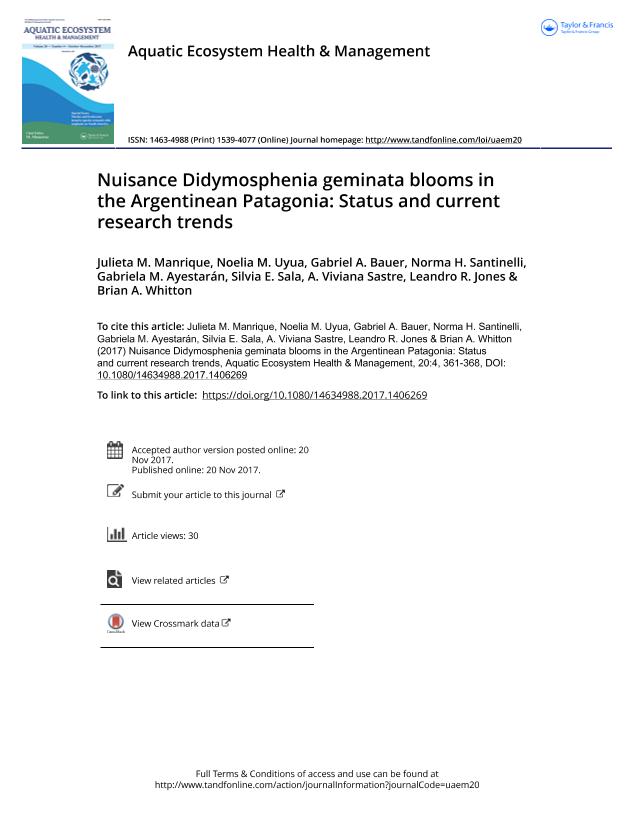Artículo
Nuisance Didymosphenia geminata blooms in the Argentinean Patagonia: status and current research trends
Manrique, Julieta Marina ; Uyua, Noelia Mariel
; Uyua, Noelia Mariel ; Bauer, Gabriel A.; Santinelli, Norma Herminia; Ayestarán, Gabriela M.; Sala, Silvia Estela; Sastre, Alicia Viviana; Jones, Leandro Roberto
; Bauer, Gabriel A.; Santinelli, Norma Herminia; Ayestarán, Gabriela M.; Sala, Silvia Estela; Sastre, Alicia Viviana; Jones, Leandro Roberto ; Whitton, Brian A.
; Whitton, Brian A.
 ; Uyua, Noelia Mariel
; Uyua, Noelia Mariel ; Bauer, Gabriel A.; Santinelli, Norma Herminia; Ayestarán, Gabriela M.; Sala, Silvia Estela; Sastre, Alicia Viviana; Jones, Leandro Roberto
; Bauer, Gabriel A.; Santinelli, Norma Herminia; Ayestarán, Gabriela M.; Sala, Silvia Estela; Sastre, Alicia Viviana; Jones, Leandro Roberto ; Whitton, Brian A.
; Whitton, Brian A.
Fecha de publicación:
12/2017
Editorial:
Taylor & Francis
Revista:
Aquatic Ecosystem Health And Management
ISSN:
1463-4988
Idioma:
Inglés
Tipo de recurso:
Artículo publicado
Clasificación temática:
Resumen
Large nuisance blooms of Didymosphenia geminata have become increasingly widespread in Patagonia. Although the first published account for South America was in 1964, reports of large growths in Chile and Argentina commenced around 2010. Since then, these blooms have been observed all along the Andes region to the south of parallel 42°S. General surveys are needed to help provide an explanation. Possibilities include one or more new genetic variants or responses of local populations to global environmental changes. Electron microscopy of material from the Argentinean Patagonia revealed marked differences between regions, though it is unclear how much local factors and/or variations in life cycle contribute. Thus, we are approaching the problem from a molecular perspective, which we hope will help to overcome this limitation. Initial studies showed that D. geminata seems to be highly recalcitrant to DNA extraction, thus hindering the survey of molecular markers. We have now developed an improved DNA extraction technique for Didymosphenia mats, which markedly outperforms other techniques. However, endpoint polymerase chain reaction analyses suggest the persistence of polymerase chain reaction inhibitors in the samples, highlighting the need of further improvements for quantitative studies.
Palabras clave:
ARGENTINA
,
DIATOM
,
INVASIONS
,
PHYLOGEOGRAPHY
Archivos asociados
Licencia
Identificadores
Colecciones
Articulos(SEDE CENTRAL)
Articulos de SEDE CENTRAL
Articulos de SEDE CENTRAL
Citación
Manrique, Julieta Marina; Uyua, Noelia Mariel; Bauer, Gabriel A.; Santinelli, Norma Herminia; Ayestarán, Gabriela M.; et al.; Nuisance Didymosphenia geminata blooms in the Argentinean Patagonia: status and current research trends; Taylor & Francis; Aquatic Ecosystem Health And Management; 20; 4; 12-2017; 361-368
Compartir
Altmétricas



